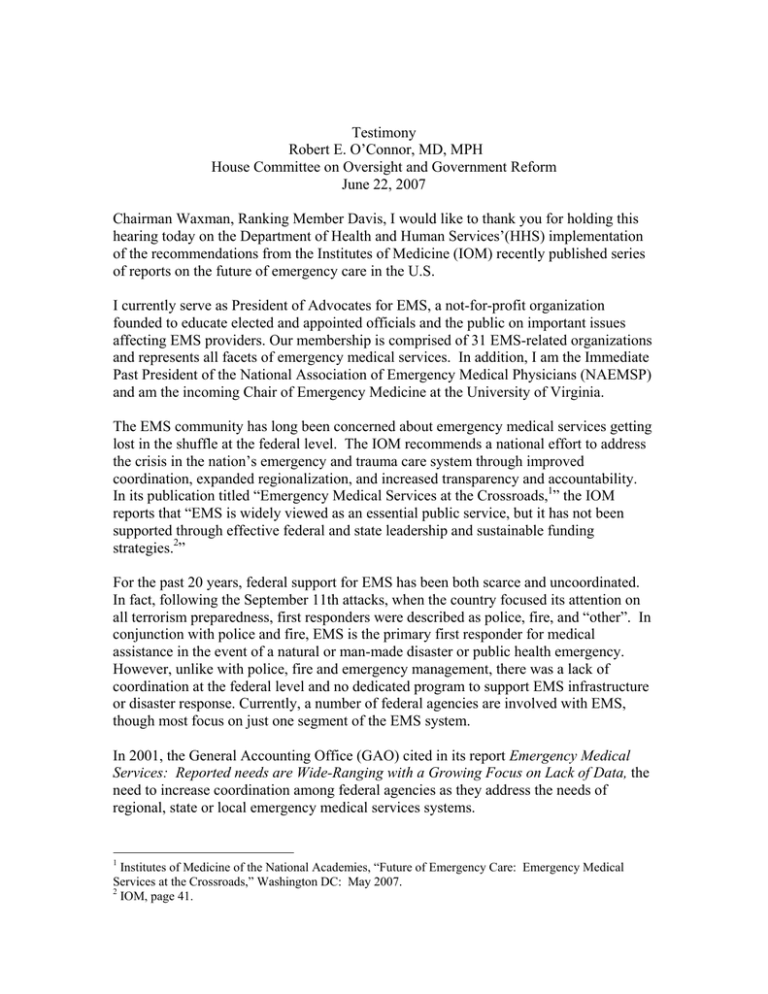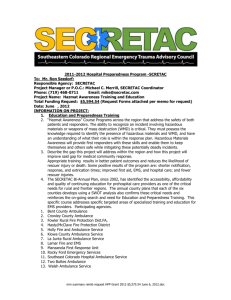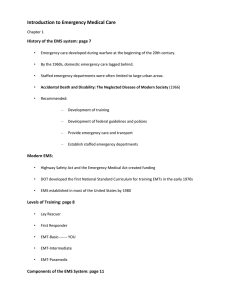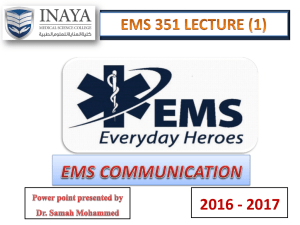Testimony Robert E. O’Connor, MD, MPH
advertisement

Testimony Robert E. O’Connor, MD, MPH House Committee on Oversight and Government Reform June 22, 2007 Chairman Waxman, Ranking Member Davis, I would like to thank you for holding this hearing today on the Department of Health and Human Services’(HHS) implementation of the recommendations from the Institutes of Medicine (IOM) recently published series of reports on the future of emergency care in the U.S. I currently serve as President of Advocates for EMS, a not-for-profit organization founded to educate elected and appointed officials and the public on important issues affecting EMS providers. Our membership is comprised of 31 EMS-related organizations and represents all facets of emergency medical services. In addition, I am the Immediate Past President of the National Association of Emergency Medical Physicians (NAEMSP) and am the incoming Chair of Emergency Medicine at the University of Virginia. The EMS community has long been concerned about emergency medical services getting lost in the shuffle at the federal level. The IOM recommends a national effort to address the crisis in the nation’s emergency and trauma care system through improved coordination, expanded regionalization, and increased transparency and accountability. In its publication titled “Emergency Medical Services at the Crossroads,1” the IOM reports that “EMS is widely viewed as an essential public service, but it has not been supported through effective federal and state leadership and sustainable funding strategies.2” For the past 20 years, federal support for EMS has been both scarce and uncoordinated. In fact, following the September 11th attacks, when the country focused its attention on all terrorism preparedness, first responders were described as police, fire, and “other”. In conjunction with police and fire, EMS is the primary first responder for medical assistance in the event of a natural or man-made disaster or public health emergency. However, unlike with police, fire and emergency management, there was a lack of coordination at the federal level and no dedicated program to support EMS infrastructure or disaster response. Currently, a number of federal agencies are involved with EMS, though most focus on just one segment of the EMS system. In 2001, the General Accounting Office (GAO) cited in its report Emergency Medical Services: Reported needs are Wide-Ranging with a Growing Focus on Lack of Data, the need to increase coordination among federal agencies as they address the needs of regional, state or local emergency medical services systems. 1 Institutes of Medicine of the National Academies, “Future of Emergency Care: Emergency Medical Services at the Crossroads,” Washington DC: May 2007. 2 IOM, page 41. During the 108th and 109th Congress, the EMS community worked closely with members of both the House and Senate to authorize the Federal Interagency Committee on Emergency Medical Services (FICEMS) that would serve to coordinate the various Federal agencies that are involved in EMS, including HHS, the Department of Homeland Security (DHS) and NHTSA at the Department of Transportation. On August 10, 2005, the FICEMS was signed into law as part of H.R. 3, the Safe, Accountable, Flexible, Efficient, Transportation Equity Act – A Legacy for Users (SAFETEA-LU). The new FICEMS is beginning its work this year. The new, fully-formed FICEMS is the ideal body to consider the lead agency issue and fully form a consensus on how to best organize and perhaps realign federal support of EMS systems. It will greatly enhance coordination among the federal agencies involved with the state, local, tribal and regional emergency medical services and 9-1-1 systems and help assure that Federal agencies coordinate their EMS-related activities and maximize the best utilization of established funding. In addition, the FICEMS is required to submit an annual report to Congress to help provide members of Congress with information on emerging Federal EMS issues. HHS Funding Support for EMS Systems Development Currently, there is very little funding support for EMS at the federal level. The vast majority of funding for EMS comes from the Centers for Medicare and Medicaid Services in the form of below cost reimbursement for ambulance runs. Outside of that funding source, there is very little federal discretionary funding dedicated to the development of EMS systems for daily operations or disaster preparedness. There used to be a few, small EMS programs at HRSA that were recently eliminated in the appropriations process. A rural EMS grant program existed to support training and equipment for smaller communities and it was eliminated in the FY 2006 Labor HHS appropriations bill. The Trauma Systems Planning grant program had $3 million and was eliminated in that same year. The program was reauthorized this year and we are hopeful that Congress will provide some funding for this vital program. There remains a $20 million EMS for Children program at HRSA that focuses on pediatric emergency medicine. Historically, HHS used to provide significantly more resources for EMS. As stated in the recent IOM reports, in 1973, Congress enacted the EMS Systems Act, which created a new grant program to develop regional EMS systems which at the time did not exist. In total, more than $300 million was appropriated at HRSA for EMS planning, operations, expansion, improvement and research. This is equivalent to over $1.5 billion in today’s dollars. In 1981, under the Reagan Administration, the Omnibus Budget Reconciliation Act eliminated this categorical funding for EMS to states and folded the funding into what is now the Preventive Health and Health Services Block Grant at the Centers for Disease Control and Prevention where states 16 states spend approximately $8 million of the total $99 million block grant on EMS. I should note that the last three Administration budget requests have proposed elimination of this block grant program, but the Congress has restored this funding in the final appropriations bill. Clearly more dedicated federal funding support for EMS is needed within HHS to support EMS systems development for daily operations and emergency preparedness; especially by the historical standard of 26 years ago when there was an emphasis on these critical public health needs. One of the IOM recommendations to address surge capacity, training and protection of hospitals and staff is for Congress to significantly increase total disaster preparedness funding for hospital emergency preparedness in the following areas: • • • • Strengthen and sustain trauma care systems; Enhancing ED, trauma centers and inpatient surge capacity; Enhancing the availability of decontamination showers, standby ICU capacity; negative pressure rooms and appropriate personal protective equipment; and Conducting international collaborative research on the civilian consequences of conventional weapons (CW) terrorism. In addition, the IOM recommended that all institutions responsible for the training continuing education and credentialing and certification of professionals involved in emergency incorporate disaster preparedness training into their curricula and competency criteria. According to reports issued by the Department of Homeland Security, EMS providers continue to receive less than four percent of approximately $3.7 billion in funding available to first responders in FY 2002, 2003 and 2004 from programs where EMS is eligible to receive first responder grant funding. In addition, EMS receives about five percent of the $450 million Hospital Bioterrorism Preparedness grant funding. Congress needs to make improved disaster response training and equipment for EMS providers a priority. The FY 2007 Department of Homeland Security Appropriations Report requested another report by the Department examining EMS first responder grant funding levels. The report was due on January 23rd of this year. However, the Department has yet to issue the report. The EMS community is eager to review the report. History of the Medicare Ambulance Fee Schedule On April 1, 2002, the Centers for Medicare and Medicaid Services (CMS) implemented a fee schedule for the Medicare reimbursement of ambulance services. Under the new fee schedule, ambulance service providers are no longer able to bill any portion of their services at the previous “reasonable charge” rate. The new reimbursement system has resulted in significantly lower reimbursement rates for many ambulance providers nationwide. Congress took temporary action to help struggling ambulance providers in the Medicare Modernization Act of 2003 (MMA). The MMA language provided desperately needed relief to a majority of the ambulance service providers receiving the largest payment reductions under the Medicare ambulance fee schedule and to ambulance service providers who serve very rural communities. From 2004-2009, ambulance providers and suppliers may be paid the greater of (1) the national fee schedule, or (2) a blend of the national fee schedule and a regional fee schedule established by CMS. The MMA also included a number of temporary reimbursement increases to further support ambulance providers, including a temporary increase for ground transports, long trip adjustments, and a “super rural bonus.” Most of these relief provisions expired in 2006 and none of the relief provisions have adequately addressed the enormous impact the fee schedule is already having on patient access to ambulance services. Recent reports from government and industry confirm that the average reimbursement levels of the single largest payer of ambulance services, Medicare, are below the average cost of providing the service. The GAO recently submitted a report to Congress showing negative Medicare margins for many ambulance service providers. The report stated that the average Medicare payments for ambulance services are six percent (6%) below the average cost per transport.3 As part of the Medicare Modernization Act (MMA) of 2003, Congress requested that the GAO to study the “cost, access, supply and quality of ambulance services under the Medicare program.” The average cost per transport reported by the GAO in 2004 was $415 per transport.4 Findings of National Studies Collectively, the GAO, AAA and IOM reports found: • Ambulance providers are paid substantially below their average costs to provide medical transportation services to patients covered under Medicare. o GAO = Medicare payments in 2004 were 6% below average cost per transport. Payments were below costs in all three service areas: six percent (6%) for transports in urban areas, one percent (1%) for transports in rural areas and seventeen percent (17%) for transports in “super rural” areas.5 o AAA = Medicare payments in 2004 were 8% below average cost per transport.6 • Medicare’s share of transports is greater than Medicare’s share of payments. o GAO = Medicare patients represent 40% of total transports while comprising only 31% of total revenue.7 3 Government Accountability Office, “Ambulance Providers: Costs and Expected Medicare Margins Vary Greatly,” GAO-07-383, Washington DC: May 23, 2007, page 24. 4 GAO, page 24. 5 GAO, page 24. 6 AAA, page 26. 7 GAO, page 11. o AAA = Medicare patients are the largest share of total transports for ambulance providers, with 44% of total transports, while comprising only 41% of total revenue.8 • • Ambulance services provide more uncompensated care than any other major healthcare provider group, including hospitals and doctors. o AAA = The average uncompensated care burden for America’s ambulance providers ranges from 10.8% to 16.5% of all ambulance care. By comparison, U.S. hospitals report an average of 5.6% in uncompensated care, while physicians report an average of 4.3%.9 Medicare reimbursement does not adequately fund the cost of readiness. o IOM = EMS costs include the direct costs of each emergency response, as well as the readiness costs associated with maintaining the capability to respond quickly, 24-hours a day, 7-days a week—costs that are not adequately reimbursed by Medicare.10” Payment Shortfall is Estimated to be Even Greater Than Reported The AAA estimates that the Medicare payment shortfall is even greater than reported based on the factors below: • Volunteer Labor Understates GAO Cost. The GAO included volunteer ambulance services in the analysis, defined as providers with more than 20 percent of labor from volunteers. The presence of significant volunteer labor understates the estimated average cost of ambulance transports, especially since volunteer labor is prevalent in rural areas. • Impact of Uncompensated Care Adds about 3% to the Shortfall. Neither the GAO nor the AAA estimates includes Medicare’s share of uncompensated care. Based on the Medicare bad debt burdens of other health care providers, actual Medicare margins are estimated to be roughly 3 percentage points lower than those shown by the GAO. • Need for Capital Reserves Adds about 5% to the Shortfall. Both the GAO and AAA estimates assume zero margins which are necessary for providers to reinvest in the service’s infrastructure, such as finance capital improvements in technology, communications systems, equipment and facilities. Both reports also assume zero reserves for responding to natural disasters or terrorist attacks. The Impact of Below-Cost Reimbursement It is critical that the rates of the single largest payer, Medicare, are high enough to cover the costs of an efficient, full-cost, high-quality provider. 8 AAA, page 35. AAA, page 50. 10 IOM, page 7. 9 • EMTs and Paramedics earn almost 30% lower wages than comparably trained personnel working in hospitals and nearly 50% less than other public safety roles. A comparison of wages published by the U.S. Bureau of Labor Statistics11 among healthcare workers with similar educational requirements, the average annual wage of EMT/Paramedics in 2006 was $29,390, while the average annual wage of Licensed Practical and Licensed Vocational Nurses in 2006 was $37,530, a 27.7% difference. Similar analysis shows ambulance personnel earn nearly 50% less than police officers and firefighters. • Many communities are forced to rely on unpaid staff. Ambulance providers are unusual due to their substantial use of volunteers. In 2004, two-fifths of the ambulance industry relied substantially on volunteer staff.12 Chronic below-cost reimbursement, especially in rural and super-rural areas is widely viewed in the industry as a major reason that ambulance providers rely heavily upon unpaid staff. • Below-cost reimbursement threatens service quality. According to the IOM, “overall, the new fee schedule significantly reduces Medicare payments to EMS providers. . . As a result, local EMS systems may now need greater subsidization from local governments or may be forced to reduce costs through personnel cuts, reductions in capital expenditures, or other means.13” Furthermore, chronic below-cost reimbursement erodes service delivery over time including increased burn-out of personnel, use of older vehicles and equipment, more expensive maintenance, and inability to reinvest in new technology, lifesaving drugs and emerging medical treatments. An emergency medical services system serves as the safety net for the local health care system and individuals who call 9-1-1 for an emergency medical services transport when all other sources of help are exhausted. A comprehensive, coordinated emergency medical services system that has adequate resources for staffing, training and equipment is essential to assure prompt, quality care to persons experiencing medical crisis. On behalf of the pre-hospital and hospital-based emergency care associations and providers we look forward to working with you as you consider this issue further. 11 U.S. Department of Labor, Bureau of Labor Statistics, “Occupational Employment and Wages,” May 2006: Washington DC. 12 GAO, page 10. 13 IOM, page 47.






